#korean language blog
anon asked: what’s the difference between -는 동안 and -(으)면서? I’m so confused
This is a great question! I am assuming you’re asking because they can be translated as the same thing into English. I understand why there will be confusion because, under context, these grammar points aren’t really distinguishable in English as they are in Korean.
-는 동안; while, during [goherefor more]
Use this when:
- You’re not talking about the same doer of the action [엄마가 설거지를 하는 동안 아빠는 화장실을 청소했어요 - Mom cleaned the dishes while dad cleaned the bathroom]
- You are talking about the same doer of the action [어제 공부하는 동안 문제가 생겼어요 - I found a problem while studying yesterday]
- The doer of the action is inanimate [비가 많이 오는 동안 구름이 어두워졌어요 - the clouds darkened while it poured]
Try to remember that 동안 is used for a period of time; “-는 동안”은 일정 기간 동안 사용되다. Consider the example in the first rule. Think of the context of this sentence as: during the time it took for my mom to do the dishes, my dad cleaned the bathroom. Yes, you can switch it around because contextually it means the same thing, “아빠가 화장실을 청소하는 동안 엄마는 설거지를 했어요.”
NOTE:Because “-는” attaches to the dependent clause [엄마가 설거지를 하는 동안], the verb before it does not take tense and underlyingly takes the tense of the independent clause’s verb [아빠는 화장실을 청소했어요]. I used the past tense [과거] in my examples, but you can use the present tense [현재] or future tense [미래], obviously, depending on what you want to say.
More Examples:
- 한국에서 사는 동안 한국어를 빨리 배웠어요 - While I lived in Korea, I learned Korean quickly.
- 대학교 디니는 동안 어디에서 살 거예요? - Where are you going to live while attending University?
- 아빠가 저녁을 준비하는 동안 저는 보통 숙제를 해요 - I usually do my homework while my dad makes dinner.
- 희주가 세수하는 동안 혜민은 이를 닦았어요 - While Heeju washed her face, Hyemin brushed her teeth.
- 제가 자는 동안 고양이는 제 식물을 먹었어요 - While I slept, my cat ate my plants.
-(으)면서; while
Use this when:
- The doer of the action is the same [희주는 먹으면서 유튜브를 봐요 - Heeju watches YouTube while eating]
- The action is happening simultaneously [지하철을 기다리면서 친구하고 전화했어요 - I waited for the metro while I called my friend]
- Contrasting two actions [대현은 한국에서 일하고 싶다고 하면서 한국어를 못해요 - Daehyun said they wanted to work in Korea, but they don’t speak Korean]
NOTE: You can only use -(으)면서 when talking about the same doer of the action or state. For example, 희주는 일하는 동안 음악을 들었어요 and 희주는 일하면서 음악을 들었어요. BOTH work and are grammatically correct. The working and listening to music is being done by 희주, whether at the same time, or during work. However, a sentence like “희주는 일하면서 혜민은 음악을 들었어요” is grammatically incorrect. Even if 희주 and 혜민 are doing this at the same time, you must use -는 동안.
More Examples:
- 샤워하면서 노래를 불렀어요 - While showering, I sang
- 요리하면서 요리법을 봐요 - While cooking, I read a recipe
- 수업을 들으면서 메모를 해요 - I take notes while in class
- 운전하면서 문자를 보내지 마세요 - Don’t text while driving
- 희주는 숙제를 하면서 음악을 들어요 - While Heeju does her homework, she listens to music
Differences between the two:
- You can use 동안 with nouns [명사], you cannot use (으)면서 with nouns. However, you can use (이)면서 with nouns in conjunction with 이다 [저는 대학생이면서 선생님이에요 - I am a university student and a teacher]. This expresses two states of being that happen at the same time.
- You can not use -는 동안 to contrast actions
- You MUST use the same doer of action with (으)면서
- -는 동안 expresses an action that occurs during a period of time; -(으)면서 does not necessarily take place at a specific time
Similarities between the two:
- You attach tense at the end of the sentence, you cannot attach tense to the dependent verb
- They are, most of the time, interchangeable; just remember the rules above
BONUS! -(을/ㄹ) 때; when
The closest origin of “때” I could find in 한자 is “時”. “때” refers to an event/time/period of action (another translation of 時 can be 시).
Things to remember:
- You can use -때 with nouns and -(을/ㄹ) 때 with verbs.
- Because it refers to a specific moment, you can attach tense to -(을/ㄹ) 때
- You can use this with adjectives!
- Can be used with -까지 and -부터! [때 + 부터 = since// 때 + 까지 = until]
Examples:
- 비행기를 도착할 때 엄마하고 전화할게요 - When my plane lands, I’ll call my mom
- 대학생[이였을] 때 돈이 없었잖아요 - When I was a uni student, I didn’t have money, as you know
- 한국 친구에게 한국말로 하기 시작했을 때 마이클은 깜짝 놀랐어요 - When I started speaking Korean to my Korean friend, Michael was surprised!
- 공부할 때 음악을 들어요 - When I study, I listen to music
- 시간이 있을 때 알려주세요 - Let me know when you have time
- 16살 때부터 한국어를 배웠어요 - I’ve been learning Korean since I was 16
- 이렇게 될 때까지 더 씻어야 해요 - You have to wash it more until it’s like this
- 한국에 갈 때 홍대하고 제주도 방문하고 싶어요 - When I go Korea, I want to visit Jeju and Hongdae
- 혜민 언니는 한국에 들어갔을 때 제가 너무 슬펐어요 - I was so sad when Hyemin when back to Korea
- 어렸을 때 그림을 그리기 시작했어요 - I started drawing when I was a kid
Hope this helps! If there’s any more confusion, please, don’t hesitate to send another message or ask!
Happy Learning :)
~ SK101
(으)시 vs Deferential [Korean Honorifics]
anon asked: what’s the difference between 먹다 and 드시겠습니다. You say they both mean eat but i am confused? Help!
@femaletype asked: next do (으)시 vs -세요 vs -ㅂ/습니다 Bc honorific vs deferential is the bane of my existence
First, I will give a list of honorific verbs and nouns, then explain the honorific ending! It’s important to note an “elevation” of formality; who is being elevated! In this case, there are three types:
- verbs that elevate* the subject
- verbs that elevate the object
- verbs that elevate the recipient of the action (usually used with the honorific particle 께)
*elevate = who are talking about in an honorific way?
높임말 동사; Honorific Verbs
- (2) 만나다 / 보다; 뵙다 [to see, to meet]
- (1) 먹다; 드시다 / 식사하다 / 잡수시다 [to eat]
- (1) 마시다; 드시다 [to drink]
- (3) 주다;드리다 [to give]
- (1) 있다; 계시다 [to stay]
- (1) 죽다; 들어가시다 [to die]
- (1) 아프다; 편찮으시다 [to be hurt/in pain]
- (1) 말하다; 말씁하시다 [to speak]
- (1) 자다; 주무시다 [to sleep]
- (3) 묻다; 여쭈다 [to ask]
- (1) 배고프다; 시장하시다 [to be hungry]
- (2) 데리다; 모시다 [to accompany]^
^ the plain form 데리다 is more commonly used as a compound verb with 오다 or 가다, but that can be it’s own separate post if people are interested.
높임말 명사; Honorific Nouns
- 이름; 성함 [name]
- 나이; 연세 [age]
- 집; 댁 [house]
- 생일; 생신 [birthday]
- 밥; 진지 / 식사 [food, meal]
- 병; 병환 [disease, illness]
- 술; 약주 [alcohol]
- 아이; 자제분 [child]
- 이; 치아 [tooth]
- 말; 말씀 [word]
It’s important to note, that outside of these specific verbs, you can realistically elevate any verb in Korean using (으)시.
-(으)시 vs. (스)ㅂ니다; Deferential Honorific
At this point, you should be familiar with plain style conjugation patterns (-어/아요). The deferential style is the infamous -(스)ㅂ니다 that gives the statements their formal ending. Of course, as we know, -(스)ㅂ니다 is more formal than -어/아요. If at any point, you are unsure as to which formality to use, always use the deferential style.
Honorifics can attach to both the deferential and polite styles, but are used in different contexts illustrated below:
- [polite]집에 가요 - I’m going home
- [deferential]집에 갑니다 - I go home
- [polite + (으)시] 집에 가세요 - Go home, (hon. subject)
- [deferential + (으)시] 집에 가십니다 - (hon. subject) goes home
Remember, you cannot, ever, at any point, ever, use (으)시 for yourself.
-(으)세요
When (으)시 is attached to the polite style conjugation, there are two usages; (1) to show respect, (2) to create an imperative.
The use of -(으)시 elevates the subject, object, or any recipient of the action who is older, in a higher position, or placed above you in respect. Of course, you will hear some Koreans complain about this politeness hierarchy, however, that is not an excuse to speak in an intimate way to a doctor, professor, or an elder–this is not about being close, this is about being respectful.
The biggest difference between the deferential -(스)ㅂ니다 and the honorific -(으)시 is that one acknowledges the elevation of the subject/object/recipient of action [-(으)시] while the other acknowledges the formality of the environment around them [-(스)ㅂ니다].
When talking to someone closer to your age (seemingly), you are able to use [polite + (으)시] to express politeness without being overtly formal. This is why, in restaurants, you will use phrases like:
- 순두부찌개 하나 좀* 주세요 - please give me tofu stew
- 물 좀 주세요 - please give me water
- 아아 한잔 좀 주세요 - please give me an iced americano
*좀 softens the request
Where the server will use an honorific term:
- [드시다] 뭐 드시겠습니까? - what will you eat/drink?
- [드리다] 영수증을 드릴까요? - do you want me to give you a receipt?
Note that the -까 creates an interrogative phrase.
All that said…
You can add (으)시 to any verb in order to create it’s honorific counterpart. This goes for literally any verb. If you are truly lost and cannot remember how to use the honorific form of 먹다 then you can use some form of 먹으시다. Examples:
- [to answer/reply] 대답하다 + (으)시 = 대답하시다
- [to sing] 노래부르다 + (으)시 = 노래부르시다
- [to listen] 듣다 + (으)시 = 들으시다
Hope this helps! Honorifics are honestly difficult. So difficult, that even switching formality without honorifics is still considered rude (from intimate to plain to deferential). You’ll hear people say it’s okay to not use the proper formality because you’re a foreigner, but I think that’s a lazy solution to learning. If you want to learn properly, do it properly.
Example Sentences:
- 무슨 책을 읽으세요? - what book are you reading?
- 한국 분이세요? - are you Korean?
- 한국어를 가르칠 사람은 김 선생님이세요 - Mx. Kim will teach Korean
- 엄마가 전화하셨어요 - My mom called
- 부모님께서 은행에 가셨어요 - My parents went to the bank
That being said, it’s okay to mess up formalities so long as you catch the mistake and correct yourself. The listener (older Korean or friend) will greatly appreciate the self-assessment.
If there’s still some confusion, let me know!! Happy Learning :)
~ SK101
p.s. for more conjugations, you can go here!!
anon asked: what’s the difference between 끊다 and 자르다?
Great question! Hopefully my answer helps! Both can mean “to cut” but here’s a better explanation:
One is used abstractly, while the other is used for more concrete situations. When you want to cut something for a recipe, or cut a piece of paper, you use 자르다. When you want to hang up the phone, or quit smoking, you use 끊다.
끊다 - cut (something abstract); not a literal cutting of something
- 이만 끊을게요 - I’ll hang up (on the phone)
- 앞으로 담배를 끊을 거예요 - From now on, I’m going to quit smoking.
자르다 - cut (something concrete); a literal cutting of something
- 종이를 반으로 자르세요 - cut the paper in half
- 이렇게 잘라야 해요 - you should cut it like this
- 머리 잘라서 머리가 짧아졌어요 - my hair got shorter because I cut it
Hope that helps! Happy learning :)
~ SK101
anon asked: hi! i’m still in the process of learning hangul and i know there’s is no specific order to learn korean but what was the easiest route for you? this may sound silly because i’m thinking too far ahead but when/how did you get to the point of not having to use a dictionary or translator for everything? or is that something i’ll always have to do? i’ve only learned one other language and it was spanish. i think i was able to pick up on it quicker because of cognates that are similar to english and i think those also exist for english and korean but i find them more difficult to identify due to the alphabet being different. i hope i didn’t make it sound confusing. thank you for any tips! i appreciate it all
안녕하세요! 늦게 네 질문이 읽어서 미안해요!
이걸 기억하세요: 여러분은 새로운 언어를 배울 때 항상 사전을 사용할 거예요.
만약 한국어를 배우면 다른 사람들마다 다 배우는게 달라요. 우리가 이걸 이미 알고 있었어요. 그렇지만 사람들은 한국어를 대화하지 않으면 한국어를 배우지 못해요. 우리는 “아 한국에 가려고 한국어를 배워"라고 말하지만 한국어를 사용하는 나라에 살지 않아서 한국어를 배우기 어려워요. 우리 한국말로 말해야 돼요. 진짜로요.
저는 한국사람들과 한국어로 대화했기 때문에 한국어를 쉽게 배울 수 있었어요. 매일 한국어 문법과 어휘도 배우는데 한국말을 사용하지 않으면 기억을 못해요. 항상 "쓰기, 읽기가 제일 쉬워"라고 생각하고 듣기, 말하기 연습을 안 했어요. 16 살때부터 한국어를 배우기 시작했어요! 지금 22살이잖아요!! 제가 왜 한국말로 편하게 말할 수 없었을 가요?!
한국말로 대화하지 않았기 때문이에요.
이건 제 충고예요. 만약 한국어를 쉽게 배우고 싶으면 한국말로 해야 돼요. 너가 문법과 어휘도 배워야 되지만 말하기도 해야 돼요. 하루에 5분이라도요
도움이 됐으면 좋겠습니다. 잘 배우세요.
ENG Trans.:
Hello! Sorry for reading your message late.
Remember this: when you’re learning a new language, you will always use a dictionary (in a way, fluency is arbitrary).
If you want to learn Korean, everyone learns different. Of course, we already knew that. However, if a person doesn’t speak in Korean, then they won’t learn Korean. We say things like, “I am learning Korean to go to Korea,” but most of us don’t live in a country that actively uses Korean. That makes it really hard to learn Korean. If we wanna learn, we have to speak Korean. Seriously.
It wasn’t until I spoke to native Korean speakers that I actually learned Korean easily. Everyday, I would learn grammar or vocab but it would mean nothing to me if I didn’t use it. I would forget it. I used to think, “Writing and reading are the easiest,” but I never practiced speaking and listening. I’ve been learning since I was 16!!! I’m 22 now!! Why couldn’t I speak Korean comfortably???
It’s literally because I never spoke in Korean.
This is my advice. If you want to be comfortable in Korean (with or without a dictionary), use it. Learn the vocab and grammar, but you HAVE to speak Korean. Even if it’s just for 5m a day.
I hope this helped! Happy Learning :)
~ SK101

동의 agree/consent
투표 vote
뜻 wish/opinion
여부 whether or not
에 앞서(서) ahead of
적립되다 to be raised/saved
공개하다 to make public/release to people
숫자 number
N + 당 per N
걸리다 to hang/be at stake
액수 amount
따라서 therefore
돼지 저금통 piggy bank
포기하다 to give up
유가족 bereaved family
각각 each
씩 each
전달되다 to be delivered
빈손 empty hand
총 total
동의서 agreement
조 article (in a law or contract)
항 section (in a law or contract)
임의로 randomly/of your own accord
중단 interruption/discontinuance
중단하다 to discontinue an action (used in formal settings)
_짓을 하다 to do something _ (used with adjectives)
무사하다 to have nothing bad happen
실종되다 to disappear/go missing
방금 soon (past)
금방 soon (future)
아마 probably/likely
풀다 to release
위치 position/location
추적 trace/track down
끝장 final stage/unfortunate end
끝장아야 it’s the end/you’re done for
거부하다 to refuse
처리되다 to be dealt with/disposed of
과반수 majority
쓰다vs적다
Both of these mean ‘to write’ and for the longest time I was just using whichever one whenever I felt like it, but actually there is a slight difference to be aware of. 쓰다 means ‘to write’, like ‘to write a letter’ or ‘to write a book’. But 적다 specifically means ‘to write something down’ like a memo or a phone number. My Korean teacher usually asks us ‘적어주세요’ when asking us to note something on the board after dictation, but she also says ‘써주세요’ at times when she wants us to write any text that we created ourselves.
- 저는 제 여동생을 위해 시를 쓸게요-I will write a poem for my younger sister
- 저는 이 빈칸에 제 이름을 적을거예요 - I will write down my name in this blank space.
하숙집vs기숙사vs고시원
I used to have a tough time remembering the difference between these accommodation spaces - I guess the take home message is that all of these are multi-person living spaces, but there is definitely a clear distinction.
하숙집 is a boarding house - the kind of place where you live when you are renting a room in a house where other people also live - sometimes things like food and laundry are provided too. It gives off a very ‘living with a host family’ vibe, even if you are pretty much house sharing with other people of a similar age.
기숙사 are college/university dorm rooms - mostly you will share a room with someone else (or more than one person… sometimes 3 other people!). When you think of the word ‘dormitory’ you are probably thinking of a 기숙사.
고시원 have you ever seen the KDrama ‘Strangers From Hell’? (kinda scary). Anyway the place where they live is a 고시원 - they are TINY narrow rooms for individual use but all the other amenities are shared. There are no other added luxuries at all but the rent is usually cheap which is why students sometimes find themselves there.
자연vs천연
When talking about nature, I’ve always used 자연in it’s noun form, such as ‘I like nature - 저는자연을 좋아합니다’. Or even in it’s adjective form (자연스럽다), ‘Just speak naturally - 그냥자연스럽게말씀하세요’…. but I only recently realised there is another way to say ‘natural’.
So천연 also means natural in the adjective form, but really it’s referring to something that has never been processed or changed out of its natural form (e.g. it is naturally occurring on earth, like mountains or the sea). An easy way to remember this is that the meaning of the first character 천(天) means sky, which is a reminder that it came from the heavens.
I read a really good example (credit here) about cotton, which has a few terms in Korean. One of these is for the natural product that is picked off plants (솜) and another is for the fabric that we use day-to-day (면).솜is naturally occurring therefore you would use 천연 to describe it, but you could never use 천연with면 because it has to be processed (changed) to make that fabric (you would use 자연instead).
But apparently it’s common for people to intentionally use both of these interchangeably so that they can indicate that a product is actually more natural than it really is.
찾다vs발견하다
Almost all Korean learners will know that 찾다 means ‘to find, to search for, to look for’ etc. Well, 발견하다 means ‘to discover, to find’. The distinction in Korean is as clear as it is in English. 찾다 is used when finding something that you already know exists, whereas 발견하다 is used when finding (discovering) something that you didn’t know was there before. For example:
- 시계를찾았어요! = I found my watch!
- 저는 새로운 서점을 발견했어요 = I found (for the first time) a new bookstore
체험vs경험
With these two words we’re talking about ‘experiences’ - but two slightly different nuances. 경험 is a general past experience - this is something that you have done before, and as a result got an experience from it. For example, work experience, the experience of travelling abroad, the experience of waking up late for school etc. The key thing is that it is an event that happened in the past.
However체험 mostly talks about something that you feel/experience directly - like a spiritual experience, or experiencing hardships, or experiencing the feeling of zero gravity. It infers more of a present moment feeling rather than 경험 which is talking about things that have definitely already happened. So, 경험 is almost like the knowledge you get after experiencing something (체험).
- 자동차 열쇠를 잃어버렸다고? 나도 그런 경험이 있어… - Did you say you lost your car keys? I have had that experience too..
- 저는 그 사고를 매일 다시 체험해요 - I re-experience that accident every day
의류vs옷
Firstly, big shout out to @epfks for messaging and asking for this to be included in the next post!
Both of these mean ‘clothing’ or ‘clothes’ - I’m sure all of you will know옷, but fewer people will know 의류.옷 is a native Korean word, whereas 의류 has a Chinese root (衣類 - 衣 means ‘clothes, covering’, 類 means ‘kind, type, category’). In the past I have mentioned that words with Chinese roots tend to be more formal than the native Korean word - that is also true here. 옷is an everyday word, but 의류 is much less used unless you’re using it in a professional sense. You could think of clothes on two different scales, a small (personal) scale and a large (industrial) scale - 옷가게 (a clothes store) vs 의류 산업 (clothing industry) - you couldn’t interchange 옷and의류 in these situations, it just doesn’t feel right. 옷 refers more to the actual clothes that a person wears, but 의류 is often used to refer to a type of clothes (e.g. 남성 의류 - men’s clothing), the clothing/fashion industry, or to sound more formal, like ‘garment’.
목표vs목적
Both of these words mean ‘goal’ or ‘aim’ like to have a goal/aim to achieve something, but there is a subtle nuance between them. It can be easy to confuse the two, and whats worse is that, often, translation apps translate both of these words to ‘goal’ in English - but there is a difference:
- 목표 refers to a goal or target that you might have - an overall large thing that you are working towards, maybe like a goal for next year (New Years Resolution), a goal to get into college, or a sales goal/target that your company might meet. For example: 제 목표는 올해 TOPIK II 시험에 합격하는 것이에요 =My goal is to pass the TOPIK II exam this year. Here I used 목표- it is an overarching target I am working towards.
- 목적 however is talking about an aim or purpose of something rather than a goal - it refers to the reason/purpose for doing something, such as the aim of a lesson, the purpose for the meeting, etc. For example: 제가 한국어 수업을 듣는 목적은 올해 TOPIK II 시험에 합격할 수 있도록 도와주는 것이에요 =The purpose of me taking Korean classes is to help me pass the TOPIK II exam this year. Here I used 목적 as it is an aim, objective, purpose of something.
관념vs개념
These two words mean ‘idea, concept, notion’, like you have an idea about something, or you understand the concept of something (abstract thinking). Actually, the meaning of these two words are quite similar so it is easy to get them mixed up, but largely it is understood if you were to confuse them - the difference is almost a philosophical thing….
- 관념 refers to ideas and opinions that people naturally have about something (ideas that naturally appear in the mind), as well as any abstract/not realistic ideas about things (e.g. stereotypes about things/people, beliefs etc). e.g. 강박관념 = an obsession (literally: a compulsive idea), or 고정관념 = a stereotype (literally: a fixed idea)
- The Hanja (觀念) means: 觀 = to see, observe, view; 念 = to think of, study, recall. So it means, you see something and form an idea (without knowing more).
- 개념 refers to concepts (ideas) about something that have been formed after reviewing evidence on the topic (e.g. the concept of space, or time etc.), e.g. 시간 개념이 없었어요 = I had no concept of time (I lost track of time).
- The Hanja (槪念) means: 槪 = generally; 念 = to think of, study, recall. So it refers to generally held thoughts (concepts understood by many people)
법vs법률vs법칙
If you are this far in your Korean studies (or like a good legal KDrama, like me), you will have come across as 법 as a word to mean ‘law’. 법 indeed means ‘the law’, as in ‘You broke the law - 너는 법을 어겼다’.법률 talks about a specific law, act or legislation within the legal system e.g. ‘새 법률 = a new law’.
Meanwhile법칙 doesn’t necessarily have anything to do with the legal system. It refers more to ‘principles of something’, like Newton’s Laws of Motion, or the law of gravity.
There are actually numerous nouns with the 법 stem in it, which I don’t want to overload everyone with - but these are some common ones that come up a lot. I’ll cover some other ones in a later post.
변호사vs법률가
Keeping with the law theme for the final word difference (was I watching a lot of legal dramas when I was making my list for this post? I can’t remember). When most Korean learners learn occupations, we all learn 변호사 to mean ‘lawyer’ - this is a typical lawyer who will argue a person’s case in accordance to the law, and who you may often find in a courtroom.
So then…. what is a 법률가? I saw this in a book and was like…. wait, is this a lawyer too? Actually if you look closely at the word, it has 법률 in it (legislation) - these people are experts in laws and legislations, and have studied the law in great detail (and sometimes are lawmakers too). This is a term that is used to describe a legal scholar more than a lawyer arguing a case (although these people might also be practicing lawyers too!)
Hi guys - just wanted to drop by and say hello, post a little personal update and thank your for your patience since I’ve been absent for almost 3 weeks. A bunch of people sent me some lovely messages and hopefully I have got back to everyone by now, but if you left a comment and I haven’t seen it, I’m very sorry - hopefully I’ll see it soon.
I had to take a bit of a mental health break due to some unexpected stuff going on over here - not really a break from studying, but more just cutting down my activities to an amount that felt manageable with the energy that I had, but I have still been reading in Korean most days and studying my vocabulary decks every day. Everyone, don’t forget to give yourself breaks and days off too! It’s super important for us in the long run to prevent burnout.
If you guys are ever curious about what I ACTUALLY do day-to-day with my language study activities, I actually set up a language Twitter account two/three weeks ago, so you can now find me posting regularly on @jeitrix227, or on Instagram @jeilylanguage. Otherwise I’m bouncing back with a lot more energy after my break and will be posting some more This vs That posts and situation phrases over the next two weeks Hope you are all keeping safe, happy and healthy and wishing you all a wonderful February!

Hi all! Back to share one of the latest, absolutely essential, new additions to my Korean language learning. It is called Mirinae - it is a web tool that breaks down Korean sentences into their component parts to help you understand form and structure of Korean sentences and analyse grammar even in the most complex of writing. Let’s take an indepth look under the ‘Keep Reading’ cut

The main interface looks like the image below. Extremely straight forward. Type (or copy) your text into the text bar below and hit enter. I am just going to use one of Mirinae’s pre-set examples for this demo.

It generates a break down of the sentence, identifying each component part and explaining its use within the sentence, as well as the full English meaning below.

You can click on the different grammar structures for more information, or you can collapse some of the grammar information if you want a less detailed breakdown. You can also click on each word to get more indepth meaning too. In the picture below I have simplified all the grammar fields, and clicked on the connector ‘다고 하여서’ for more information.

As well as this, Mirinae can also detect your spacing errors, so it can be perfect for checking the accuracy of your own writing. In the picture below, I copied a sentence from this Naver news article, and took the final space out to see if Mirinae would spot it.
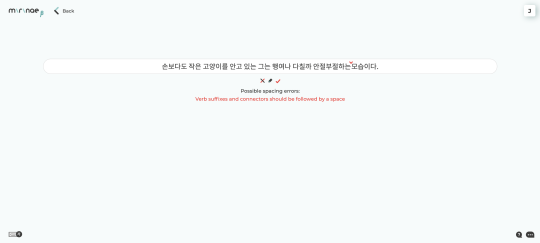
Not just this, but it also has an awesome glossary to help you understand all those horrible grammar terms, and also a grammar reference section that you can access. It categorises grammar points by use/function, and also by level so you can make sure that you are learning grammar that is within your range. When Mirinae is analysing your work, it lets you know what level grammar you are using as well, which is quite helpful to know. The picture below is only a very very tiny snapshot of the endless grammar and idiom reference list that Mirinae has.

So….. all in all, Mirinae is a big hit in this household! I hope you can all make use of it, genuinely it is changing my life and the way that I analyse text, as well as how I write. These days, instead of checking any writing on Papago, I go through Mirinae first. It is just an extremely informative tool.
You can access Mirinae at the following URL: https://mirinae.io/#/ I don’t know how new it is, but it seems like it is pretty new on the scene and it is still in Beta mode so might have even more new and exciting updates in the near future! Let me know how everyone gets on!
NB: Post is a little long this time - lots of examples and explanation - sorry!
이따가vs나중에
Here’s something that trips me up at even the best of times - both mean ‘later’ but they imply slightly different things. ‘이따가’ indicates that something will happen a short time later - usually within a few hours, whereas ‘나중에’ doesn’t really have a time inference - the time period can be either long or short, so it can be used in every situation. However you might prefer to use 이따가 instead to emphasise that the time is short, for example if you ask someone to wait for you and say to them, “I will come back later”, you can say “이따가 다시 올게요” to emphasise that the waiting time will be short. If you use 나중에 instead, the person cannot tell how long they might be waiting.
외롭다vs고독하다
Hopefully here are some words you won’t have to use too often - both give off a meaning of ‘lonely’.외롭다 will be the adjective that most people are familiar with in meaning ‘lonely’ or ‘feeling lonely’, whereas 고독하다 is an even more intense feeling of loneliness. 고독하다 is more like ‘solitude’ - like that feeling of intense loneliness when you are on your own for long periods of time.
인생vs삶vs목숨
There are numerous ways to say ‘life’ in Korean and it can get a little confusing so let’s break down just three common terms from the numerous options.
인생is made up of the Chinese characters 人生, the first of which means ‘person’, therefore 인생 refers to the life of a human and not the life of other living things (plants or animals) or objects, e.g. “Life is worth living - 인생은 살 가치가 있어요" or “What is the meaning of (human) life?- 인생의 의미는 무엇인가요?”
However,삶is life as a concept, or life as an existence - it refers to a living thing’s existence on Earth. e.g. “Grandmother lived a good life [existence] - 할머니는 좋은 삶을 사셨어요" or “Cats live a perfect life [existence] - 고양이는 완벽한 삶을 사요"
목숨 has quite a specific use - the word is composed of 목 (neck) and 숨 (breath) to refer to breathing as the primary function of a human or animal’s life. The easiest way to conceptualise 목숨is as ‘life that can be lost’ - it indicates the idea that a person or animal either has breath in their body (living), or does not have breath in their body (not living). The ‘breath in your neck (목숨)’ can be risked, in danger or lost, so you will likely only see this term in those kinds of sentences. e.g. “I’m risking my life-목숨이 위태로워요" or “My life is in danger - 제 목숨이 위험해요"
시도하다vs노력하다vs-아/어보다
All of these mean ‘to try to do something’ but each have quite different uses. 시도하다 holds more of a meaning of ‘to attempt something’ - it is quite formal in the same way that in English you wouldn’t normally say “I will attempt to do it” when speaking amongst friends, therefore it is more likely to be seen in writing than speaking. e.g. “Suzy attempted singing - 수지는 노래를 시도했다”
You could instead (mostly) use 노력하다 for less formal and less intensive situations, but it gives off a feeling of trying to do something that requires quite a lot of effort, or something that needs long-term effort, e.g. “I will try (really hard) -노력할게요”
On the other hand, -아/어 보다 is used all the time and indicates that you will try something (possibly for the first time) with the aim of experiencing what that thing is like. It doesn’t require a lot of effort, and it is probably not something that will go on for a long time, e.g. “I will try eating kimchi - 김치를 먹어 볼게요“
대단하다vs대박vs신기하다
All of these are terms are common words used to express amazement, and largely could be interchanged without much trouble, but I delved a little deeper to understand the differences and here is what I found:
대박 (대박이다) has two meanings:
- Totally cool / really great - an expression to indicate positive feelings or a positive reaction towards something or someone, e.g. “최우식의 새 영화는 대박이다! - Choi Wooshik’s new movie is so cool/great/amazing”
- Completely surprising - an expression to indicate shock or surprise and can be used in both positive or negative situations to mean ‘Wow!’ ‘No way!’ ‘That’s unbelievable’ ‘That’s unreal’, e.g. “복권에 당첨됐나요? 대박!! - Did you win the lottery? That’s unbelievable!!” or “남자친구랑 헤어졌다고? 대박….-You broke up with your boyfriend? No way….”
These two meanings can overlap from time to time, like in the lottery example, but dividing them into two like this, makes the other two terms easier to understand. 대단하다means ‘a huge amount’ or ‘enormous’, but in expression form it means ‘outstanding’, ‘amazing’, so it has the same use as the first meaning of 대박, e.g. “와 대단하다-Wow, this is amazing.”
Meanwhile,신기하다 means something is amazing in a surprising kind of way, so it is closely related to the second meaning of 대박 - however it is not often used with negative meanings, e.g. “네가 아직도 그걸 기억하다니 신기하구나-It’s amazing/surprising that you still remember that” or “우리가 이 곳에서 만난 건 신기하다-It’s amazing/surprising/unbelievable that we met each other here [without planning to meet]”
Hi guys! Happy New Year (lol its January 6th - I’m so late). I hope that everyone who was celebrating had a really lovely festive season and that all of you had a nice start to the new year. Wishing you all health, happiness and huge language gains for the year ahead (haha! very important).
Before I get back to the regular type of posts for this year, I just wanted to let you all know about the Korean Book Club that I have joined. It is an initiative that was set up by someone wonderful that I follow on Instagram (ID: clickystudies) as an effort to keep all of us active with our reading goals for the year.
Here’s how it goes:
- There is one common book that all of us will read throughout the whole year. [TITLE: 1일 1페이지, 세상에서 가장 짧은 교양 수업 365] (you can buy it on Google Play Store for around $6-7 or something - link here and image below) - it is a book with 365 articles so there is one text piece for every day of the year! NEAT. The articles are about a whole bunch of varied worldtopics and was only published in 2019 so it is super relevant still. The level is probably around Intermediate+ levels but a bunch of Beginners learners are also finding the text really useful for vocabulary learning so far!
- If you wish to, you could post your progress using the hashtag #2021KoreanBookClub on whatever social media platform you like to use.
- You can join the Discord group where each day we share notes, vocabulary lists, help each other to understand the text better, and just generally chat. If you want to be a part of the Discord group, please message clickystudies on Instagram and ask if you can join the Book Club - they will walk you through the process of joining.

I only just joined yesterday actually, so I have 6 days of reading to catch up with, but each article is distinct and standalone, so even if you are joining us late, you can just catch up in your own time - no rush at all and no pressure to read the past texts either.
The book club is a pretty social thing, but if you don’t want to join the Discord group, you could always work through the 365 book on your own, at your own pace (you don’t even need to do one a day!). Choose whatever works for you, but personally - I find the Discord channel motivating and it reminds me to read my chapter if I still haven’t read it for the day.
There are a few other books in this 365 series - one on Famous people and one on Modern Culture (both published in 2020, so super current info!), which you could also check out if you like! I guess I’ll tackle those in subsequent years. My reading list is sorted until January 2024 (hahah!!)
If you decide to join the book club, let me know! I’m @jeilylanguage on the Discord (that’s my IG name). Or if you’re going to work through the book on your own, drop me a comment or a message and let me know how you find the book! Enjoy all and good luck with your Korean reading for the year!
Ordering food in a restaurant in Korea is one thing, where you can point at the menu or pick up context clues from body language and surroundings. But what about when you want to order food delivery somewhere and you can only rely on the voice on the other end of the phone. It can be a little tricky but if you at least know the key phrases and vocabulary, it hopefully won’t be as daunting.
Phrasesyoumightsaytothedeliveryservice
In the following phrases, anything that is contained within the following brackets < > can be replaced with your own preferred food order.
- 여보세요 - Hello (obviously)
- 지금 배달되나요? / 지금 배달돼요? - Are you delivering now?
(You can remove 지금 to purely ask ‘Are you delivering?’) - <후라이드 치킨 하나, 떡볶이 하나> 주세요 - One (portion) of fried chicken and one tteokbokki please
(You could replace 주세요 with 가져다 주세요 ‘please can you bring’, or 배달해 주세요 ‘please can you deliver’ to be more specific but it’s not totally necessary) - <콜라>도 주세요 - Cola also please
- 얼마예요? - How much is it?
- 얼마나 걸려요? - How long will it take?
- 카드 돼요? - Is card okay?
- 카드로 결제할게요 / 현금으로 결제할게요 - I will pay by card / I will pay by cash
Phrasestheymightsaytoyou
- 어디세요?- Where? (asking where to deliver to) OR:
- 주소 말씀해 주세요 / 주소 말해 주세요 / 주소 어떻게 되세요 - Please tell me your address / What is your address?
- 주문 어떻게 되세요? / 어떤 제품 주문하시겠습니까? - What is your order? / What (product) would you like to order?
- 다른 더 필요한 거 없으십니까? - Is there nothing else you need?
(Don’t forget the rules of yes or no in Korean are different to English. If you say 네 [yes] to this question, that means ‘I don’t need anything else’, and if you say 아니요 [no] to this question, that means ‘Yes. I need something else’. I find it a little easier to just answer ‘있어요’ or ‘없어요’ to get around the tricky yes/no situation) - 주문 확인해 드리겠습니다 - I will check your order
- 금액은 <25,500>원입니다 - The total price is 25,500 won.
- 현금으로 결제하시겠습니까? - Will you be paying by cash?
- 알겠습니다 - Okay.
Of course, there are numerous other things that they might say to you, but these are the key phrases you need. As long as you have the vocab from here, you should be able to at least figure out what is being said and rustle up an appropriate answer.
Also it’s worth noting that the phone conversation will normally just end with them thanking you and you thanking them back (or in the reverse order), then they will hang up. There doesn’t need to be any other formal goodbyes.
NB. As I was pulling this together, it made me remember that ordering food at a restaurant could throw some really random phrases your way so I’ll make sure to do a restaurant post at some point later if people will find it helpful!

평일vs주중
Most people are taught 평일 quite early on to talk about ‘weekday’, but actually it technically is not the opposite of ‘weekend (주말)’. The opposite of 주말 is actually 주중, which refers to Monday to Friday. So, what about 평일 then? 평일 is very similar to 주중, but actually it refers to a ‘working day’, relating more to the average non-rest day which, for most people, is Monday to Friday. If a public holiday falls on a weekday, that day is technically not a ‘평일’ as people will not be working, but it is still a 주중 (a weekday). You will hear both of these used quite a lot, and mostly used interchangeably.
*For anyone that finds Hanja helpful - 주말 has the characters 週末 which means ‘final part of the week’, and 주중 has the characters 週中 which mean ‘central/middle part of the week’. Whereas 평일 has the characters 平日 which means ‘average day’.
담vs벽
Both of these mean ‘wall’ but the distinction is actually very clear between the two. 벽 is a wall in a building, such as the four walls of your room, or the walls of your house (바람벽 is specifically a partition wall for inside the house, but 벽 is sufficient). 담 is a wall that has a purpose of guarding or preventing entry, such as a fence or a perimeter wall (like a city wall, or a wall around a building). It is usually used when talking about outside walls or fences.
놀이동산vs놀이공원vs놀이터
Playground? Since all these words start with the same two characters, it might be confusing to some regarding whether there is actually any difference here. 놀이터 is a playground that children usually play in, with slides and swings and climbing apparatus. Meanwhile 놀이공원 and 놀이동산 are used when talking about an amusement park with lots of fun rides for all ages. Both 놀이공원 and 놀이동산 are actually completely interchangeable with each other, it’s just that 놀이공원 has a Chinese root, and 놀이동산 is pure Korean. Either is fine and both are used in almost equal amounts, but it is useful to know that they mean the same thing.
늦다vs지각하다
I think one of the earliest words everyone will have learned is 늦다 to mean ‘late’. This can be used universally to mean ‘late’ and can be used for all contexts and subjects. However there is a more specific term for a person being late to work or to school which is 지각하다. Although you can use 늦다 in school and work settings too, 지각하다 is more specific. You will hear 늦다 far more, but it is good to be familiar with its more specific counterpart.
사무실vs사무소
I’m sure everyone has heard of 사무실 to mean ‘office’, but did you know that 사무소 also means ‘office’? The difference is quite subtle though. These words are derived from Chinese, so it is a difference of one Chinese character. 사무소 (事務所) has a final character which means ‘place’ or ‘location’, whereas 사무실 (事務室) has a final character which means ‘room’. Therefore 사무소 refers to an office as a general location or place, e.g. real estate office, law office, maintenance office, whereas 사무실 refers to a specific office room, e.g. this is my office, I’m walking into the office now.
This is actually kind of specific to if you want to actually live in Korea but I was revising this topic today and thought it would be useful to share some of my learnings - of course there are going to be a lot more things you might want to ask or tell the realtor, but this will be a good starting point:
Thingsarealtor/estateagentmightsaytoyou:
- 어떤 집을 구하세요 -What kind of house/home are you looking for?
- 월세를 구하시나요? 아니면 전세를 구하시나요?-Are you looking to rent (monthly rent)? Or are you looking to lease?
- 금액은 어느 정도 생각하고 있어요?-Approximately what total cost are you thinking?
- 원룸은 어떠세요? - What about a one room? (a studio apartment)
- 한번 보러 가실래요?-Would you like to go to see it?
- 주인에게 연락할게요-I will contact the owner
- 계약금을 가지고 오셨어요?-Did you bring the contract fee?
Thingsyoumightwanttosaytoarealtor/estateagent:
- 아파트를 구하고 싶은데요-I want to look for an apartment
- 월세를 구해요-I am looking for a monthly rent (apartment)
- 방이 2개 있는 아파트를 구해요-I am looking for an apartment with 2 rooms
- 지하철 역에서는 거리가 얼마나 걸리나요?-How far is the distance from the subway station?
- 몇 층이에요?-What floor is it on?
- 건물에서 엘리베이터가 있나요?-Is there an elevator in the building?
- 보증금은 얼마나 되나요? -How much is the deposit?
- 조금 비싼데요. 조금 더 싼 아파트는 없나요?- It’s a little expensive. Do you have a slightly cheaper apartment?
- 그 아파트는 특징이 있나요?-Does the apartment have any special features/characteristics?
- 관리비가 있나요?-Is there a maintenance fee
- 계약하려면 어떻게 하나요?-How do I sign the contract?

Image from: 구해줘! 홈즈 (Where Is My Home - MBC)
I have been discussing resources with a few people on private message and have been thinking a bit about what resources were the best on my journey…. so here’s my final (maybe) compilation of resources for the year that will hopefully be helpful for anyone who is looking at resources between the beginners and upper intermediate levels.
NB. This list is based off materials I have used in the past and is not an exhaustive list of ALL the resources I have used - it is just a selection of some of my favourite. There are so many Korean resources out there so there might be some that work more for you that I haven’t even looked at.
CourseTexts
In my opinion, the perfect course text isn’t going to teach you everything you need to know, but a good course text will at least give you a clear framework to chunk up and guide your studies. I have used a few but the most user friendly one is definitely:
- Talk To Me In Korean -they set things out clearly so nothing feels overwhelming and provide a sensible framework to follow for self-study. Other course books tend to be better suited for in-class settings and not great for self-study.
Grammar
The course texts will teach you about grammar but I think they don’t teach you how the grammar structures are related to each other. So I think it is key to look at one or more of these books:
The above series is incredible and a serious MUST for all Korean learners. They clearly and concisely set out the grammar points and show how they are all related to each other. There is an Advanced book as well which I have yet to use and will teach quite complex structures.
- Basic Korean: A Grammar and Workbook (I have linked the forthcoming version being released in Dec 2020!)
- Intermediate Korean: A Grammar and Workbook
The above Routledge series is great for its workbook feature. The layout is a little academic so it’s not super appealing but the way they explain grammar is clear and relatively detailed. The number of examples included in the workbook is fantastic, providing a lot of opportunity to practice. I haven’t used the Basic book but if it is anything like the Intermediate, it will be a winner.
Vocabulary
The part that people often miss out when learning Korean is vocabulary, because it can be so easy to just follow course texts and grammar books, but those will never teach enough words. To learn more vocab, it is really important to read around. There are so many Korean language books that you can pick up, but here are some books and resources that are catered specifically for language learners that I have loved:
- Korean Culture in 100 Keywords-they give a paragraph on different cultural aspects of Korea in both Korean and English and highlight all the new vocabulary for you. The texts are graded from easy to more difficult.
- News in Korean-lots of short news stories with translations in English and comprehension questions. Might be targeted more at intermediate learners
- Mind Map TOPIK VOCA 2300-this book sorts vocabulary into categories and shows them as mindmaps. It also gives readers sentences in context and has mini quizzes, HOWEVER it is written in 98% Korean so this is a book that is definitely more pitched at upper intermediate levels and above and teaches vocabulary that is a little less common
- Anki-my most used resource. Everyone has their own favourite for flashcards and this is mine. Anki do spaced repetition meaning that it will constantly test your knowledge on vocabulary, spacing the quizzes/tests depending on how difficult you find the word. It is more efficient than other flashcard platforms, but it is a little tricky to get started and create your own cards. If you want to download pre-made decks, you can, but this works best when you add the words you have learned yourself so that you get decks that are full of vocab that is relevant for you
- Beelinguapp-This is an app that has some story books written in both Korean and English. It also has an audio function so you can listen to someone reading the stories in Korean. This is neat for pronunciation and listening, and also identifying new words, however the range of stories are limited.
- Gloss-Gloss have a set of online lessons pitched at different levels which takes you through articles or texts (or audio and video), then asks a lot of comprehension questions. It follows a lesson format so it is far more engaging than your regular book, however it is a little on the difficult side.
- [EXTRA] Your First Hanja Guide-you might not want to learn vocabulary this way and it is absolutely NOT an essential, but for me it is helpful to visualise the Hanja character when seeing the relationship between words, so if you like learning words like that, then this is the book for you
Listening/Watching
Like with reading, there are multiple resources that you can use to listen to native Korean, but here are some that are specifically targeted at learners
- 여보세요-this app/website has a few short video clips and goes through slowly to examine the meaning and new words, then has a number of test quizzes through multiple choice or through speaking (via microphone). There are different clips graded by levels and the app tracks your progress and gives progress reports.
- Real Life Korean Conversations: Beginners/Intermediate -this IS a book, but it is best used in conjunction with the audio files. The book gives the script, as well as the vocabulary, and also looks at key grammar points and structures used in the conversations
Speaking
There aren’t many resources that I find great for self-studying speaking - generally you need someone else to do that with you, but here is one that I thought was quite neat:
- Teuida- I just did a very quick run through this app as it is definitely pitched at beginners, but I thought that it was a smart way of learning some basic conversational Korean. It teaches you phrases and you have to repeat them back through the microphone feedback function. Then to test your retention, they take you through a mock situation and you have to speak your answers - there is quite a strong focus on getting pronunciation correct. My biggest downsides of this app are that the free sections are really limited, AND they seem to have geared the lessons towards the idea of dating, which I just find so awkward and embarrassing hahaha!
Writing
I’m in the market to buy some writing books and have my eye on some but am waiting until I have the time to work on them, but this book is quite neat for learning different sentence structures and how to construct meaningful answers:
- Korean Q&A Sentence Patterns- this book poses a question and looks at different ways of answering it. It also shows variations of the question, then examines form. It gives an example long answer and prompts you to think about how to construct your own response using the grammar and vocabulary given
The end of the first part of NCT season is almost with us, so someone asked me if I could translate a song from the album. I chose to do Misfit since it has an MV and I only translated the verses from the MV since its a song PACKED full of new vocabulary. All the tricky vocabulary is under the cut (some really useful new words in there!)

Main vocabulary (in order of appearance)
- 맞다 = to be correct, to be right
- 자체 = self, oneself
- 숨이 턱턱 막히다 = to be suffocating, stifling
- 숨 = breath
- 턱턱 = easily, completely
- 막히다 = to be blocked, stopped
- 입다 = to wear
- 느낌 = feeling, sense
- 지겹다 = boring, tedious
- 고민 없다 = without worry
- 고민 = worry, anguish
- 끌어내리다 = to drag down, to take down, to demote
- 애써 = with effort, laboriously, with force
- 재단하다 = to judge, to cut out
- 됐다 = that’s enough
- 이대로 = like this, as it is
- 의심 = doubt
- 그저 = just
- 방법 = way, means, manner
- 맞추다 = to be in harmony, adapt, adjust
- 어림없다 = impossible, absurd, preposterous
- 비슷하다 = similar, to be like
- 모습 = appearance, look, form
- 더욱 = more, further
- 거슬리다 = to be irritated, be offended
- 날아가다 = to fly, to fly away, to be gone
- 때 = time, moment
- 마치다 = to be crazy
- 어차피 = in any case, anyway
- 마음대로 = as one likes, as you want
- 언제나 = all the time, always
- 튀어나오다 = to protrude, stick out, pop out
- 다치다 = to be hurt, injured
- 아무도 = nobody
- 막지 못하다 = to not stop, to not block
- 막하 = to block, close, enclose, stop
- 억지로 = reluctantly, forcibly
- 똑같다 = exactly the same, identical
- 틀 = mold, frame, framework
- 끼워 넣다가다 = to put in
- 끼다 = to stick in, to fasten
- 넣다가다 = to put in
- 부쉬버리다 = to break completely
- 부수다 = to break, smash, destroy
- 버리다 = to throw away, discard
- 지키다 = to guard, defend, protect OR to obey, observe
- 법 = law, act, rule
- 적당히 = adequately
- 멈추다 = to stop, halt
- 규칙 = rule
- 묻다 = to ask, inquire
- 따르다 = to follow
- 듯 = like
- 채우다 = to fill
- 목줄 = leash
- 짓밟다 = to trample, stamp on
- 높다 = high
- 조준 = aiming
- 따분하다 = boring, dreary
- 늘어놓다 (늘어놔) = to harp on, to speak at length
- 뻔하다 = evident, clear
- 닿다 = to reach, arrive
- 뻗다 = to stretch, extend, straighten
- 입 = mouth
- 쩍 = with a smack, crack, split
- 벌어지다 = to widen, to part, to broaden
- 분위기 = atmosphere, mood
- 파악 = understanding, figure out, realise
- 태도 = attitude
- 늘 = always, often
- 이기다 = to win, beat
- 기분 = mood, feelings
- 발아래 = below one’s feet
- 깨버리다 = to break completely
- 깨다 = to break, shatter
- 믿다 = to believe
- 식겁하다 = to freakify
- 삐딱하다 = to be slanted, askew
- 마주치다 = to happen to meet, eyes meet
- 망설이다 = to hesitate
- 갈 길 = long road ahead
- 멀다 = to be distant, far off
- 똑바로 = straight, truthfully
- 걷다 = to walk
- 전부 = all, everything
- 비스듬하다 = askew
Key Grammar
VERB -(으)ㄹ수록 = The more ______ the more ______
ADJ/VERB/NOUN -어/아야 되다 = have to ___ , must ____
ADJ/VERB/NOUN -(으)ㄹ 텐데 = Expresses the expected future state of something
ADJ/VERB/NOUN -(으)ㄹ지도 모르다 = It might…; You don’t know if…
VERB -지 말고 _____ = don’t do ____, do ______
NOUN -뿐 = Nothing more than ____ ; Only / Just
If you’re like me, this difference will have been puzzling you for a long time. I always notice -(으)로 가요 written in textbooks, but I just accepted that it was a variation and never figured out what it actually meant. So, let’s look at this subtle difference
First, let’s talk about -에 가요 and -(으)로 가요. Both structures mean ‘to go somewhere’, but -에 is a location marker so it marks the exact location of a place, whereas-(으)로 means ‘towards’ or ‘to’ (it also means ‘by’ or ‘by means of’ which I will not be able to cover in this post). The nuance is slightly different…. -에is talking about an exact place, whereas-(으)로 is talking about general direction.
- 어디에 가요?- Where are you going? (the exact location please)
- 어디로 가요? - Where are you going? (In what direction / towards where)
As you can see from the two sentences above, sentence one is a little more specific than sentence two, but they largely mean the same thing. I guess sentence two can be perceived as a little less intrusive. Similarly let’s compare the following two:
- 어디에 갈까?- Where should I go? (What exact place should I go to?)
- 어디로 갈까? - Where should I go? (What direction should I go in?)
Again, the first sentence is a little more specific than the second which is generally wondering which direction to head in. With this in mind, take a look at the following sentences:
- 집에 가요 - I’m going home (The focus is on your home - this is your destination)
- 집으로 가요 - I’m going towards home (maybe you are going home, or going to a restaurant near to your home first. The focus is more on the direction you are heading)
Next let’s look at a slightly different case - if we were talking about you moving house and you moved into your friend’s house, you might think that you would use -에 to indicate the location as it’s a specific location, however, also remember that -(으)로 also means ‘to’ / ‘towards’ so you would say 친구 집으로 이사했어요 (I moved towards/to my friend’s house).
As you will likely know, 에 is also a time marker, so let’s look at how these particles differ regarding time.
- 몇 시에 만날까요? - What time shall we meet (exactly what time)
- 몇 시로 만날까요? - What time shall we meet (towards what time, - more of an approximation)
The second sentence, as with the examples above, can also be used to appear less direct, so if you are asking what time a meeting is, you could choose to use 몇 시로 - but both are correct given the situation.
There are lots of nuances and uses for these two particles and it takes a bit of time to move away from solely using -에, but even just knowing the above will help you to understand the subtle difference in meaning in the above contexts!

Head over to my instagram: @catierosekorean
I’m translating some lyrics right now!
What are you studying??
As mentioned herewith my Chinese studies, I was finding it hard to naturally assimilate certain new vocab into muscle memory/everyday use. So I thought I would try an approach that would allow me to remember vocab in the long term. And be able to integrate it into my everyday life contextually. And here begins the Korean vocab iteration.
All vocab working systematically through TOPIK. This is Level 1.
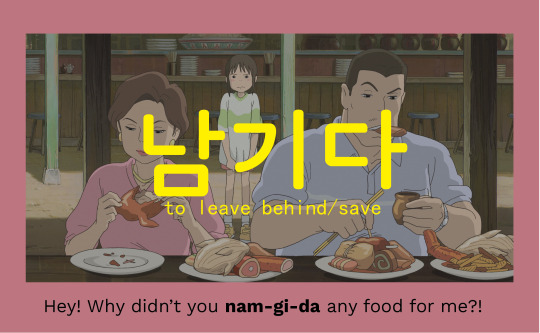
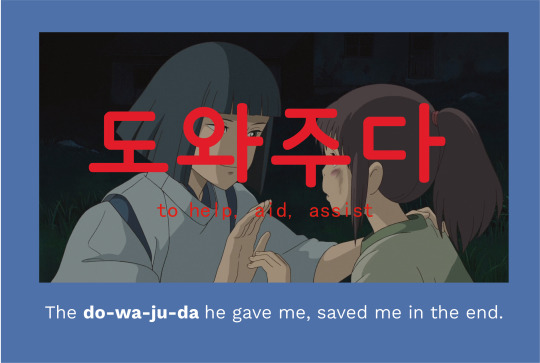
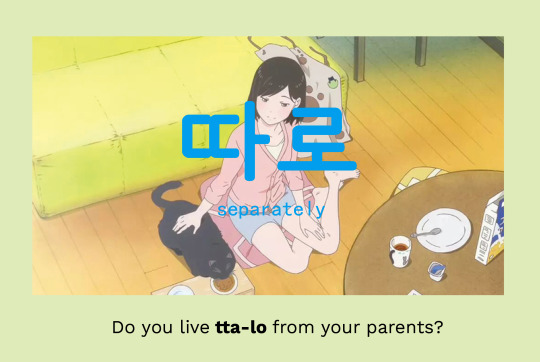




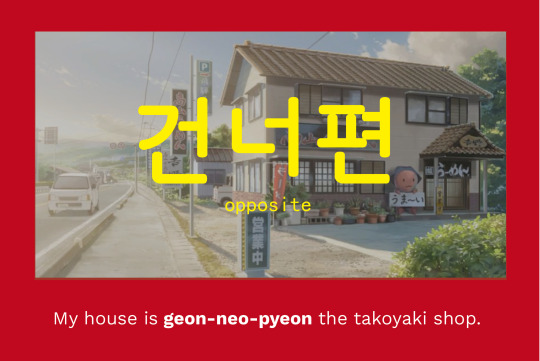
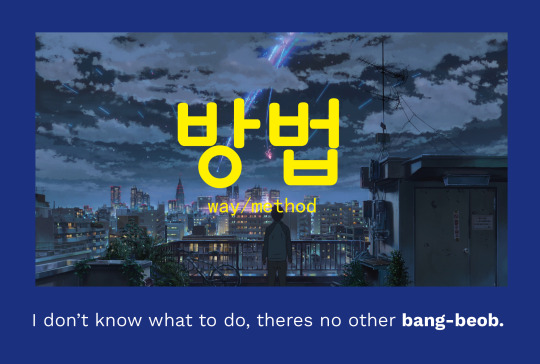



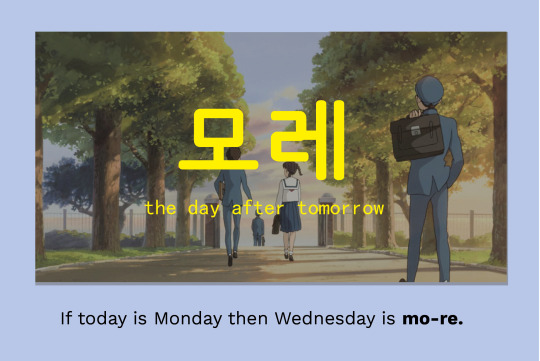

I hope these help you learn well! Something different from route learning lists of vocab. Hopefully something that sticks!
화이팅 내 친구!
